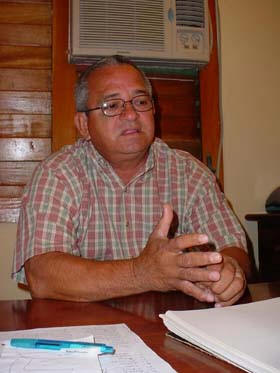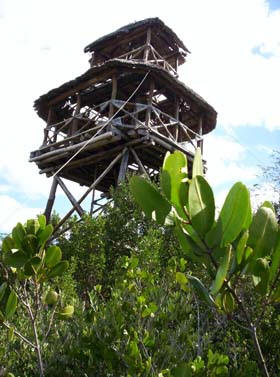

April 17, 2008
Our Dream Park?
ORTELIO GONZALEZ MARTINEZ
Those who a little over five years ago had the opportunity to watch the DVD on what would be El Baga Recreational Park would be very saddened by its current state. The project is located on the northeast side of Cayo Coco (Coco Cay) in central Ciego de Ávila province.
 JORGE MARIO
ASSURES THAT THERE WAS A LACK OF CONCERN ON THE PART OF “ALL FACTORS” INVOLVED
IN THE PROJECT.
JORGE MARIO
ASSURES THAT THERE WAS A LACK OF CONCERN ON THE PART OF “ALL FACTORS” INVOLVED
IN THE PROJECT.
“It’s a natural theme park, where you can observe a well preserved environment, and where the most important stages of Cuba’s national identity are represented,” said the narrator while beautiful scenes appeared on the screen.
“It will be made up by over 30 facilities, among which visitors will find an aboriginal village; crocodile, iguana, and chelonian farms: flamingos; forests where lizards live; a center of cultural traditions; the bats’ cave; a sundial; and the so-called Punto Bucanero (Buccaneer Spot), which will be a museum on piracy located in a life-size Spanish galleon that seems to be semi-sunken,” revealed the DVD.
THE UNFINISHED WORK
I try to look at what my eyes saw back then and I can’t see the lizard forest, the bat’s cave, the sundial, the Buccaneer Spot, and the dolphinarium, projects that were included in the investment plan and were never begun. Then, I realize that a wonderful opportunity to contribute to environmental education has been lost, especially for children and teenagers.
 ROM THIS TOWER,
CLOSED A LONG TIME AGO, IT WAS POSSIBLE TO CONTEMPLATE THE FLIGHT OF MORE THAN
30 BIRD SPECIES.
ROM THIS TOWER,
CLOSED A LONG TIME AGO, IT WAS POSSIBLE TO CONTEMPLATE THE FLIGHT OF MORE THAN
30 BIRD SPECIES.
The Convention Center is a monument to indolence and demands urgent repair. Further away, near the coastal area, the framework of what used to be the new La Roca Restaurant strives to survive amid the abundant vegetation threatening to cover it.
By the beach, the facility called the Área de Baño (Bathing area) is almost demolished, like most of the footbridges of the Taíno Village, now under slow repair work. The track of the El Baga Route has been closed for some time.
The observation tower, from where visitors could see up to 30 different types of birds in a few hours, is in very poor condition and in danger of collapsing.
Joining this abandonment is the decrease of some animal populations, especially turtles, since there’s only one left from the 14 that previously existed. According to several people interviewed the turtles either died or were stolen.
Veterinarian Abdel Blanco says that flamingos were brought in on three different times. “Some flew away due to a lack of food, others died from hunger. We hope these ones survive. Jose Morales, director of the Fauna Rio Maximo Protected Area, said he was not going to send us any more.”
The dolphinarium is another unresolved matter. Erigeniel Fleitas told Granma that a temporary enclosure was built at Los Perros Bay in 2003, located some 11 kilometers away from the park. Workers labored hard there, he commented. Most of the ground was prepared; 18 rolls of wire mesh were bought; and even two tons of mackerel were purchased to feed the animals that never arrived. Afterwards, they demolished what they had built.
Without avoiding the responsibility they may have had, Jorge Mario Gutierrez, the acting director at the time, explained that a change has been observed: “the areas are not as covered with grass as they used to be. We thinned out the trees, we are collecting waste. We want to get the El Bagá project on the best path.”
People identify El Bagá as the prehistory park, named after a tree endemic to the area, belonging to the Annonaceae family.
The materialization of the project came after a meeting held at the beginning of the current decade between the top officials from the Ministry of Science, Technology and the Environment and the Cuban Institute of Civil Aviation. They agreed on building a natural theme park taking advantage of part of the area where the old Cayo Coco Airport used to be located, seeking to lessen the environmental impact stemming from its construction.
El Bagá was never finished and that gave rise to the almost absolute lack of concern on the part of those who devised it. That influenced the mentality of the workers who lost their enthusiasm and their sense of belonging. Consecutive changes of management (seven in four years) made matters worse and the transferring of the center to the Flora and Fauna enterprise, with new ways and styles of work.
If actions are not carried out fast to rescue the park, El Bagá will continue to decrease in value.
http://www.granma.cubaweb.cu/secciones/cienciaytec/ambiente/ambiente35.htm

El parque ¿de los sueños?
ORTELIO GONZÁLEZ MARTÍNEZ
Quienes hace poco más de un lustro vieron la multimedia de lo que sería el parque recreativo El Bagá, en el noroeste de Cayo Coco, Ciego de Ávila, hoy regresarían entusiasmados ante aquella belleza proyectada.
Foto> Jorge Mario asegura que hubo mucha despreocupación por parte de “todos los factores”.
"Es un parque natural temático, donde se puede observar un entorno bien conservado, y la representación de las más importantes etapas de la formación de la identidad nacional cubana", decía el locutor al compás de las imágenes que aparecían en la pantalla.
"Estará integrado por más de 30 objetos de obra, entre los que sobresalen la aldea aborigen, criaderos de cocodrilos, iguanas, quelonios, flamencos, bosques de los lagartos, centro de cultura tradicional, gruta de los murciélagos, reloj de sol, y el llamado Punto Bucanero, que fungirá como museo de la piratería, en un galeón español de tamaño natural que simulará estar semihundido", revelaba la multimedia.
LA OBRA INCONCLUSA
Miro con los ojos de aquella primera vez y no veo el bosque de los lagartos, la gruta de los murciélagos, el reloj de sol, el Punto Bucanero y el delfinario, objetos de obra incluidos en la inversión y jamás iniciados. Entonces medito sobre cuánta oportunidad se ha perdido de realizar una efectiva educación medioambiental entre la población, y sobre todo en favor de niños y adolescentes.
Foto> Desde esta torre, cerrada hace tiempo, pudiera contemplarse el vuelo de más de 30 especies de aves.
El Centro de Convención es un monumento a la indolencia y clama por una reparación urgente. Más allá, en la zona cercana a la costa, da la bienvenida lo que fue el flamante restaurante La Roca, cuyo esqueleto pugna por no dejarse ahogar por la vegetación que lo asedia.
A la vera de la playa, el local denominado Área de Baño y Taquillas está casi demolido, al igual que gran parte de las pasarelas de la Aldea Taína, sometida a una lenta reparación. El sendero por la Ruta de El Bagá permanece cerrado desde hace tiempo.
La torre de observación donde, según afirman los especialistas, puede verse hasta 30 tipos de aves en unas pocas horas, está en mal estado, con peligro de derrumbe.
A esos percances se une la disminución de algunas poblaciones, con más incidencia en la de tortugas, que de 14 ejemplares queda solo uno, quizás, como testigo de que la especie no va a desaparecer de allí. Sus congéneres, según varios entrevistados, murieron o fueron robados.
Abdel Blanco Castillo, médico veterinario, precisa que tres veces trajeron flamencos. Unos alzaron vuelo ante la falta de comida, otros murieron de hambre. Tenemos la esperanza de que estos sobrevivan. Fefo (José Morales Leal, director del Área Protegida Refugio Fauna Río Máximo) dijo que no nos enviaba ni uno más, afirma sin cortapisas.
El delfinario es otra de las asignaturas pendientes. Erigniel Fleitas explicó a Granma que en el 2003 se construyó un recinto temporal en la Bahía de Los Perros, a unos 11 kilómetros del parque. Allí se trabajó duro, argumenta. Concluyeron gran parte del movimiento de tierra. Compraron 18 rollos de malla metálica y hasta adquirieron dos toneladas de jurel para alimentar a los animales que jamás llegaron. Después, demolieron lo construido.
Sin obviar la responsabilidad que en algún momento pudieron tener, Jorge Mario Gutiérrez Cárdenas, director en funciones en aquellos momentos, explica que se observa un cambio: "las áreas no están tan enyerbadas como antes. Raleamos el monte, recogemos los desechos¼ Queremos que El Bagá enrumbe por el mejor camino."
Como el parque de la prehistoria califican en todo el polo turístico a El Bagá, que debe su nombre a un árbol endémico de la zona, perteneciente a la familia de las anonáceas.
La idea de materializarlo surgió luego de que a principios de la actual década se pusieron de acuerdo los máximos representantes del Ministerio de Ciencia, Tecnología y Medio Ambiente y del Instituto de la Aeronáutica Civil de Cuba, para construir un parque natural temático, con el aprovechamiento de una parte del área donde estaba enclavado el viejo aeropuerto de Cayo Coco, en aras de atenuar el impacto ambiental que había ocasionado la obra.
Por entonces, el valor de lo presupuestado ascendía a 4,5 millones de pesos y unos dos millones en divisas. Al menos, esas eran las cifras que aparecían en papeles.
El Bagá jamás fue terminado y ello dio pie a la casi total despreocupación por parte de quienes lo idearon. Esa mancha influyó en la mentalidad de los trabajadores, que perdieron el entusiasmo y el sentido de pertenencia, a lo que se unen los sucesivos cambios de administraciones (siete en cuatro años) y el traspaso a la empresa de Flora y Fauna, con nuevas formas y estilos de trabajo.
Si no emprenden acciones para rescatarlo, con el paso del tiempo el mencionado Parque continuará desvalorizándose.